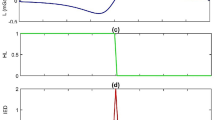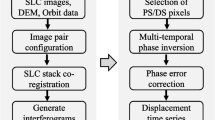Abstract
Topographic data sets are often composed of terrain samples arranged in irregular meshes. Many gradient estimation methods require the data to be arranged in a regular mesh; irregular meshes present a difficulty for them. This paper presents a novel method of estimating surface gradients from irregularly spaced inputs. The method is derived using directional derivatives and is shown to be a generalization of traditional finite difference methods. Analytical tests were used to evaluate the method, which was shown to be accurate and robust.
Similar content being viewed by others
REFERENCES
Blais, J. A. R., Chapman, M. A., and Lam,W. K., 1986, Optimal interval sampling in theory and practice, in Proceedings of the 2nd International Symposium on Spatial Data Handling, International Geographical Union, Columbus, OH, p. 185–192.
Burrough, P. A., 1986, Principles of geographic information systems for land resources assessment: Clarendon Press, Oxford, 194 p.
Dierckx, P., 1995, Curve and surface fitting with splines: Oxford Science Publications, Oxford, 285 p.
Evans, I. S., 1972, Spatial analysis in geomorphology, in Chorley, R. J., ed., General geomorphometry, derivatives of altitude, and descriptive statistics: Harper & Row, New York, p. 17–90.
Farin, G., 1993, Curves and surfaces for computer aided geometric design:Apractical guide: Academic Press, New York, 3rd ed., 473 p.
Flood, M., and Gutelius, B., 1997, Commercial implications of topographic terrain mapping using scanning airborne laser radar: Photogrammetric Engineering & Remote Sensing, v. LXIII, no. 4, p. 327–329, 363–366.
Gold, C. M., 1989, Surface interpolation, spatial adjacency and GIS, in Raper, Jonathan, ed., Three dimensional applications in geographical information systems: Taylor & Francis, New York, p. 21–35.
Golub, G. H., and Van Loan, C. F., 1983, Matrix computations: The Johns Hopkins University Press, Baltimore, MD.
Gould, P., 1981, Letting the data speak for themselves: Annals of the Association of American Geographers, v. 71, no. 2, p. 166–176.
Huising, E. J., and Gomes Pereira, L. M., 1998, Errors and accuracy estimates of laser data acquired by various laser scanning systems for topographic applications: ISPRS Journal of Photogrammetry & Remote Sensing, v. 53, p. 245–261.
Isaaks, E. H., and Srivastava, R. M., 1989, An introduction to applied geostatistics: Oxford University Press, New York, 561 p.
Krabill, W. B., Thomas, R. H., Martin, C. F., Swift, R. N., and Frederick, E. B., 1995, Accuracy of airborne laser altimetry over the Greenland ice sheet: International Journal of Remote Sensing, v. 16, no. 7, p. 1211–1222.
Lancaster, P., and Šalkauskas, K., 1986, Curve and surface fitting: An introduction: Academic Press, New York, 280 p.
Maggio, R. C., Meyer, T. H., and Siska, P. P., 1997, Spatial education using relational databases: in Proceedings of GIS/LIS '97, Cincinnati, OH, p. 432–440.
Makarovic, B., 1977, Composite sampling for digital terrain models: ITC Journal, v. 3, p. 406–433.
Makarovic, B., 1984, Structures for geo-information and their application in selective sampling for digital terrain models: ITC Journal, v. 4, p. 285–295.
Meyer, T. H., Eriksson, M., and Maggio, R. C., 1997,A Preliminary study on approximating hillslope at a point: in Papers and proceedings of applied geography conferences, Albuquerque, NM, p. 177-187.
Mitchell, A. R., and Griffiths, D. F., 1980, The Finite difference method in partial differential equations: John Wiley & Sons, New York, 272 p.
Okabe, A., Boots, B., and Sugihara, K., 1992, Spatial tessellations: Concepts and applications of Voronoi diagrams: John Wiley & Sons, New York, 532 p.
Philip, G. M., and Watson, D. F., 1986, A method for assessing local variation among scattered measurements: Math. Geology, v. 18, no. 8, p. 759–764.
Pitty, A. F., 1969, Some problems in selecting a ground–surface length for slope–angle measurement: Revue de Geomorphologie Dynamique, v. 17, no. 2, p. 66–71.
Schey, H. M., 1992, div, grad, curl and all that, an informal text on vector calculus: W. W. Norton & Company, New York, 163 p.
Skidmore, A. K., 1989, A comparison of techniques for calculating gradient and aspect from a gridded digital elevation model: International Journal of Geographic Information Systems, v. 3, no. 4, p. 323–334.
Travis, M. R., Elsner, G. H., Iverson, W. D., and Johnson, C. G., 1975, VIEWIT: Computation of seen areas, slope, and aspect for land-use planning: U.S. Department of Agriculture Forest Service General Technical Report PSW-11/1975, Pacific Southwest Forest and Range Experimental Station, Berkeley, CA.
Voronoi, G., 1908, Nouvelles applications des paramètres continus à la théorie des formes quadratiques, deuxième memoire, recherches sur les parallelloèdres primitifs: Journal für die Reine und Angewandte Mathematik, v. 134, p. 198–287.
Wehr, A., and Lohr, U., 1999, Airborne laser scanning—An introduction and overview: ISPRS Journal of Photogrammetry & Remote Sensing, v. 54, p. 68–82.
Author information
Authors and Affiliations
Rights and permissions
About this article
Cite this article
Meyer, T.H., Eriksson, M. & Maggio, R.C. Gradient Estimation from Irregularly Spaced Data Sets. Mathematical Geology 33, 693–717 (2001). https://doi.org/10.1023/A:1011026732182
Issue Date:
DOI: https://doi.org/10.1023/A:1011026732182




